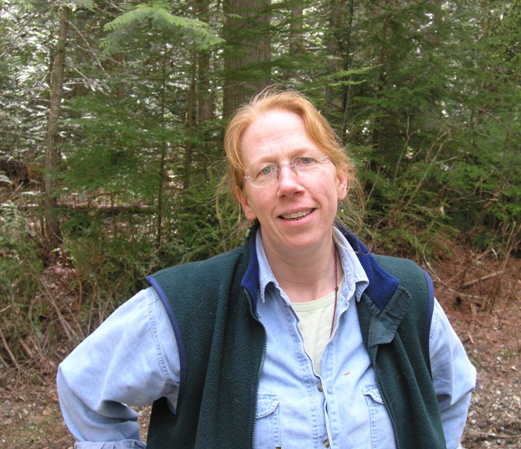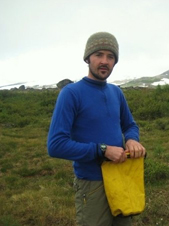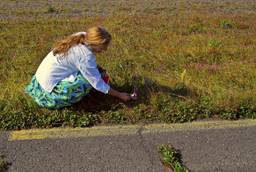Short Abstracts of Invited Speakers
-
Canadian
Society of Agronomy (CSA)
Canadian Society for
Horticultural Science (CSHS)
Canadian Botanical Association
(CBA)
Canadian Society of Plant
Physiologists (CSPP)
Canadian Weed Science Society
(CWSS)
Canadian Phytopathological
Society (CPS)
Canadian Institute of
Food Science and Technology (CIFST)-CSHS
Joint Session
-
CIFST Atlantic Section
- CSA
Joint Session
-
CSA - Organic Agriculture
Centre of Canada (OACC) Joint Session
Plenary Speakers

1.
What's With The Weather
Mr.
David Phillips, Senior Climatologist, Environment
Canada
People all over are
asking: What's happening to the weather?
It's almost as if extreme weather has become the norm -
an epidemic of ferocious, killer, catastrophic weather
everywhere. Further, the seasons seem to be out of whack,
certainly not what our teachers and parents told us it would be
like.
Is the global
climate going through unprecedented change?
Is our weather becoming more extreme? And, if so, are
people responsible or is it external forces? Or both?
Some experts suggest that we may be witnessing the
beginning of a profound climate change and bad weather may be
proof of an overheated, out-of-control planet.
There is so much we
don't know about the Earth's climate system. But what has become
clear is that the planet is warming and the number of
weather-related disasters is on the rise.
We can no longer assume that conditions in the past will
apply in the future.
Coping with more variable and uncertain weather will take more
ingenuity and adaptability – something Canadians are good at. We
also should expect more accurate, timely and credible long-lead
weather forecasts.


2.
Climate Change Impacts on Crop Production in
Canada:
Are We Heading Up or Down?
Dr. Paul Bullock,
Department of Soil Science,
University
of
Manitoba
Climate change has
been cited as a concern for future crop production but in
Canada
there are also some potential benefits. Do the positive impacts
of climate change on crop productivity outweigh the negative
impacts? Are secondary impacts of climate change more important?
Is the weak link in our predictions related to our limited
understanding of the interactions of all these effects? This
presentation will focus on the current state of our knowledge to
help us identify the gaps and better answer these critical
questions.

Society Invited Speakers
Canadian Society of Agronomy (CSA)

1.
Water Resources and Climate Change
Dr. Chandra A. Madramootoo, P.Eng;
Agricultural and Environmental Sciences,
McGill
University
The work of the Intergovernmental Panel on Climate Change (IPCC)
and several researchers has pointed to the fact that there are
likely to be increases in both precipitation intensity and
variability, thus increasing the risks of both flooding and
drought in many parts of the world. This will have an impact on
food production since both climatic extremes will limit the full
potential of our food producing lands. Such impacts will force
those involved in water for food production to explore methods
of water management that conserve water, as well as mitigate
flood damages. With irrigated agriculture producing some 40% of
the world’s food, and the need to double food production by the
year 2050, there is going to be severe competition for limited
water supplies. New irrigation techniques which make better use
of advanced soil water monitoring, management and application
technologies will, therefore, need to be developed if food
security is to be achieved.
 |
 2.
Arbuscular mycorrhiza in a sustainable world
2.
Arbuscular mycorrhiza in a sustainable world
Sustainable cropping systems will be nutrient and
energy efficient. They will favor the close cycling of nutrients
in the soil-plant-consumer systems and maintain the capacity of
the soil resources. Phosphorus management appears as a
particular challenge on this background. The arbuscular
mycorrhizal fungi (AMF) increase the synchrony between P
mobilization and crop P demand, and improve the ability of crop
plants to extract this nutrient from diluted soil solutions and
fixation sites. The arbuscular mycorrhizal symbiosis can be
managed through cropping practices favoring mycorrhizal
efficiency and using inoculants. This topic will be reviewed and
possible avenues for improving the contribution of the AM
symbiosis to sustainability, such as plant breeding, and the
manipulation of microbial interactions and plant-AMF signaling
will also be presented.

 3. Phytochemical
Antioxidants in Healthy Canadian Crops – the Good, the Better, &
the Best!
3. Phytochemical
Antioxidants in Healthy Canadian Crops – the Good, the Better, &
the Best!
Dr.
Rong Tsao,
Guelph
Food Research Centre, Agriculture and
Agri-Food
Canada
Healthy lifestyle
and good dietary habit can significantly lower the risk of many
chronic diseases such as cancer, cardiovascular diseases and
diabetes. While essential nutrients are important in maintaining
good health, in recent years, non-essential components of plant
foods, i.e. phytochemicals, have been recognised as playing
significant roles in preventing chronic diseases, particularly
those related to oxidative stress. In this presentation, I will
discuss the antioxidant phytochemicals in several unique
Canadian seed crops e.g., flax, soybean and oat, and anthocyanin-rich
fruits and vegetables, and how antioxidant, anti-inflammatory
and anti-cancer activities can be enhanced by optimising
agronomic and food processing conditions.
 4. Roots of the Second Green Revolution
4. Roots of the Second Green Revolution
Dr. Jonathan Lynch, Plant Nutrition, The
Pennsylvania
State University,
PA,
USA
Drought and low soil fertility are primary constraints to food
production in poor nations. The ‘green revolution’ of intensive
fertilizer use coupled with fertilizer-responsive varieties has
not reached the poorest nations, and is not an economically
viable strategy for the foreseeable future. What is needed is a
‘second green revolution’ that improves crop yields without
requiring intensive inputs. In recent years a number of root
traits have been identified that improve crop adaptation to
drought and low soil fertility. In this presentation I will
review these traits, their genetic control, their use in crop
breeding programs, and their agroecological and socioeconomic
effects in rural communities in developing countries.
5. Sustainability and integrity of organic farming in a global
food chains perspective
Dr. Niels Halberg, Director, International Centre for Organic
Food Systems, Denmark
Demand for organic food has increased significantly in Europe
and North America
and consumers are being exposed to an increasing number of
imported organic foods, some of which could be substituted by
similar locally produced conventional food items. Even though
demand is partly driven by altruistic motives it is difficult
for consumers and traders to know what development they support
if they buy "global organic food" in terms of e.g. environmental
impact and possible improvements in poor farmers’ livelihoods?
Studies of certified cash crop production for export in Asia and Latin America show that there are environmental benefits
of, for example, organic soybeans and oranges compared with
conventional (reduction in emissions, absence of pesticides,
biodiversity) but also that agro-ecological methods are not
always used extensively and that organic ideas and principles
are not always employed by the local farmers. Life cycle
assessments of environmental impacts accumulated along the food
chain showed that transport-related emissions contribute a
significant part of climate impact of these products. Livelihood
benefits for smallholder farmers becoming part of high value
chains may be significant but there are important obstacles for
their inclusion in global value chains.
 |
 6. Plant Biodiversity and Climate Change in Agricultural
Landscapes
6. Plant Biodiversity and Climate Change in Agricultural
Landscapes
Dr. Robert J. Hijmans, Environmental Science and Policy,
University
of California, Davis, USA
Over the past 75 years, there has been an extraordinary and
steady increase in crop productivity. It has been predicted that
this trend will change because of climate change, unless major
research and development efforts are put in place. The use of
wild and cultivated plant biodiversity for crop improvement is a
key adaptation strategy. I will discuss where and what
adaptation is most needed, and where crop improvement is likely
to be successful based on what we know about plant physiology,
past varietal change, and the management of agricultural
biodiversity by farmers. I will also speak about the potential
repercussions of failing to maintain stable growth in
agricultural productivity for the conservation of wild and
cultivated plants.
 7.
Role of plant breeding in adaptation of plants to the changing
environment – canola model
7.
Role of plant breeding in adaptation of plants to the changing
environment – canola model
Mr. Igor Falak, Canola R&ScholarOne
ManuscriptsD, Pioneer Hi-Bred Production
LP, Caledon, ON
Canola is Canada’s “Cinderella crop” that has emerged through
extensive breeding efforts.
From quality improvements and herbicide tolerance to
hybrid adoption, canola has evolved into a stable, high-yielding
crop. Extensive breeding
work is underway to further utilize genetic variability and
improve yield stability under changing environmental conditions.
Wet environments and long-term population breeding were
used to develop Sclerotinia resistant hybrids that reduce yield
losses from this constant disease threat in western Canada.
Breeding materials and experimental hybrids are being
tested in a range of stressful environments occurring across the
Canadian prairies, from water-logging to drought and cold, with
the goal of improving stress-tolerance.
8. Crop adaptation to abiotic stression
to abiotic stress
Rosalind (Ball) Bueckert
More than half
of Canada’s crop production comes from western Canada, a region
that experiences short growing seasons characterized by
temperature and moisture stress.
Historically the
region was dominated by temperate cereal production, but in
recent decades crops have included canola and pulses.
Crops from this
region have superior quality profiles, and some cultivars have
become dominant in global crop exports.
Here we will
describe weather events and the resulting abiotic stresses that
are common in prairie crop production, and show case how
specific cultivars have been successfully adapted.
We will also
examine current strategies to improve crop performance in a
warming climate.
 9.
The
Implication of Climate Change for the Canadian Seed Industry
9.
The
Implication of Climate Change for the Canadian Seed Industry
Todd Hyra, SeCan Business Manager Western Canada, Winnipeg
Manitoba
SeCan
is national not-for-profit seed distribution association that
sources and markets varieties across Canada though a network of
over 750 member companies.
The majority of members are farmer seed producers who
grow seed, process, and sell direct to farm customers.
The key to their future is providing products that will
make their customers more profitable. In his presentation, Todd
will review some practical approaches that have proven
successful in adapting to changes over the past several years.
He will provide thoughts on what is needed to ensure we have a
healthy, competitive agricultural industry – one that will allow
Canada to continue playing a key role in feeding a growing
global population.
 10.
Recent advances in the development of crop cultivars for
adaptation to changing environmental conditions
10.
Recent advances in the development of crop cultivars for
adaptation to changing environmental conditions
Yousef Papadopoulos, AAFC,
Truro,
NS
Extreme
fluctuations in environmental conditions have been attributed to
global warming. Predicted fluctuations in air temperature during
the growing season and winter are anticipated to affect the
performance and sustainability of field crops in Canada.
This presentation will
highlight the strategies used in crop breeding programs to
address the challenges and opportunities associated with the
predicted environmental changes.
With input from coauthors, this
presentation will highlight advances in the breeding programs of
corn, cereal and forage crops that have successfully
incorporated traits to ameliorate the impact of climate change.
 11.
Crop-Based Biofuel Feedstock Potential in Atlantic Canada - Nova
Scotia Model
11.
Crop-Based Biofuel Feedstock Potential in Atlantic Canada - Nova
Scotia Model
Dr. J. Kevin Vessey, Department of Biology, Saint Mary’s
University
An estimated 100,000
acres of abandoned, “inactive” farmland currently exists in Nova
Scotia. This land represents a great opportunity for cultivation
of biofuel feedstock crops without encountering the “food versus
fuel” debate. Potential biofuel feedstock crops include biomass
grasses (e.g. Switch grass, Reed Canary grass), agro-forestry
crops (e.g. hybrid poplar, willow), and convention sugar (e.g.
sugar beet) and oil seed crops (e.g. soybean and canola). While
great potential exists for cultivation of crop-based biofuel
feedstocks in the Province, forestry and marine-based feedstock
has been the primary focus to date.
12. Are Organic Farms Different?
A Canadian Perspective
Dr. Derek Lynch, Nova Scotia Agricultural College, Truro, NS
The overreaching goal of the Canadian organic standards is
to develop farm enterprises that are ‘‘sustainable and
harmonious with the environment’’. But do organic farms achieve
these goals? Are the cropping systems and rotations, soil
management practices and intensity of nutrient use, energy and
pesticide use, floral and habitat diversity etc. on organic
farms sufficiently distinct as to impart measurable and
important environmental and/or ecological benefits? Synthesizing
results of primarily Canadian research, Derek will present the
case that the specific attributes of organic farms themselves
should perhaps be considered as valuable to society as the
agricultural products of these enterprises. Organic agriculture
may thus offer an innovative and more holistic approach to the
traditional concept of ‘value added’ in agriculture.
13.
Genotype and
environment influence GABA concentration in short-season soybean
Malcolm J. Morrison, Judith R.
Fregeau-Reid, Elroy R. Cober, Ottawa, ON.
Gamma-aminobutyric acid (GABA)
is a four carbon, non-protein amino acid found in most life
forms on the planet.
The metabolic function of GABA in plants is still under
investigation. In
humans, GABA is the main inhibitory neurotransmitter in the
brain but there is no evidence that its consumption can affect
the brain. There is
clinical proof that the consumption of GABA reduces high blood
pressure in humans.
It is estimated that up to 30% of the population in most
countries have high blood pressure.
Soy foods, such as tofu, soymilk, tempeh, natto, and miso
are easily obtainable and their consumption could be a method
for a portion of the population to lower their blood pressure.
Our objective was to
determine if there were genotypic and/or environmental
influences on the concentration of GABA in short-season soybean
cultivars. Sixteen
cultivars, representing 71 years of short-season plant breeding
progress (1934 to 2003), were grown in a randomized complete
block design with 4 replications at the Central Experimental
Farm, Ottawa, ON
using appropriate agronomic and cultural practice.
When ripe, seed was harvested, and cleaned for yield and
seed weight determination.
A sample retained for protein, oil, and GABA
determination.
Protein and oil were analysed by NIR while GABA was determined
using a gas chromatograph.
There were significant cultivar, year, and cultivar x
year interactions for all characters examined.
The year affect and cultivar x year interaction indicates
that the environment influences these traits and changes the
cultivar rank order to some extent.
There was a 3 fold difference in GABA concentration
between cultivar extremes.
Plotting the year of cultivar release (YOR) against the
trait showed that yield, and oil have increased with plant
breeding while protein and GABA concentration have decreased.
These results will form the basis of a breeding program
to increase GABA concentration in food grade soybean.

Canadian Society for Horticultural Science (CSHS)
 1.
Berry Production in Forced Culture
1.
Berry Production in Forced Culture
Davide Neri, Dept. of Environment and Crop Science – Università
Politecnica delle Marche, 60131
Ancona, Italy
d.neri@univpm.it
The production of berries by forcing is increasing in
Europe. The most cultivated berries for the fresh
market are strawberry and raspberry. In the past, forcing
techniques were aimed at increasing the earliness of
June-bearing strawberry varieties. However, nowadays the purpose
is to have a year-round production, preserving berry crops
against unfavourable climatic conditions. Different forcing
techniques, both in the nursery and in the greenhouse, will be
analyzed; as well, their physiological effects on plant
architecture and fruit quality will be discussed.
 2.
Agro-Ecosystem
Approach to Understanding Environmental Stress in Fruit and
Vegetable Production
2.
Agro-Ecosystem
Approach to Understanding Environmental Stress in Fruit and
Vegetable Production
Dr.
Jean-Pierre Privé, Senator H.J. Michaud Research Farm,
Agriculture and
Agri-Food
Canada, Bouctouche
The objective of
new agro-ecosystems for the production of high value
horticultural field crops is to improve their growing
environment, thereby reducing the various stresses and
challenges from the inclement weather. A major trend in
production throughout the northern hemisphere is the use of some
form of physical protection for the crop and can range from
temporary row covers to high tunnels. Plants and fruits produced
within these new agro-ecosystems may provide a more
environmentally durable ecosystem with the concomitant reduction
in exposure to certain pathogens and an increase in marketable
fruit and vegetable quality. An integrated, multidisciplinary
systems approach to studying the effects of protected structures
on the interaction of three trophic webs (plant, disease and
insect) will be presented.
 3.
Organic Agriculture: Contributions to Sustainable Horticulture
3.
Organic Agriculture: Contributions to Sustainable Horticulture
Dr. Ralph C. Martin, Organic Agriculture Centre of
Canada
The vision
of the Organic Agriculture Centre of Canada is to have
sustainable and science-based organic agricultural systems
supporting healthy Canadian communities. With this direction and
with input from over 600 organic producers across Canada and substantial funding
commitments from industry partners, the Organic Science Cluster
was proposed. First year results from these projects are based
on research in organic greenhouse fertility management and
energy efficiency, organic vegetable nutrition, pest control,
seedling and transplant optimization and high value fruit
production pest control and season extension. Organic production
is assessed in the context of healthy food, profitability,
resilient production units and conserving air, water, soil, N, P
and biodiversity in a period of declining fossil fuels, climate
change and economic instability. Consideration is given to
reducing waste along the value chain, the accessibility and
affordability of healthy food and appropriate diets for a
healthy lifestyle. The principle of excellent agronomy and
horticultural practice rather than substituting conventional
inputs is also explored. The goal of eating well in sustainable
communities is compared and contrasted with the goal of feeding
the world.

Canadian Botanical Association (CBA)
 1.
BOTANY with a Dash of SOTL--Improving Undergraduate Botany
Curriculum Using the Scholarship of Teaching and Learning
1.
BOTANY with a Dash of SOTL--Improving Undergraduate Botany
Curriculum Using the Scholarship of Teaching and Learning
Dr. Lyn Baldwin, Department of Biological Sciences,
Thompson
Rivers
University
The Scholarship of Teaching and Learning (SOTL)
investigates teaching and student learning through observation,
reflection, and hypothesis testing.
Relatively few botany faculties have been trained in the
specifics of SOTL, yet a national network of plant biologists
represents a unique opportunity to investigate the key questions
we face in our teaching.
In this session, I will describe the SOTL projects I am
investigating — one on the use of drawing as a learning tool in
botany laboratories and one on how to improve undergraduate
writing skills.
Participants will be invited to identify the critical questions
in the teaching of plant biology and the role that a national
collaboration of plant biologists could play in addressing these
questions.
2. Teaching and Evaluating Scientific Writing
Dr. John Markham, Department of Biological Sciences, University
of
Manitoba
Proper science education requires students to acquire a number
of communication skills. One of the most important of these is
written communication. Traditionally, the focus in teaching
science writing has been in having students write lab reports
and essays. Anecdotally, it seems that that the amount of
writing in undergraduate programs has been decreasing but there
are no statistics available to verify this.
I will be presenting the results of a survey of trends in
student writing in biology programs across the country. The
survey addresses the quantity and variety of writing students
are involved in, and gauges how these trends have changed over
the last decade.

3. Lichens and
Allied Fungi of Old Wet Cedar (Thuja
occidentalis) Forests in
Northeastern North
America:
Indicators of Environmental Change
Dr.
Stephen R. Clayden,
New Brunswick
Museum,
Saint John
Old wet
Thuja occidentalis
forests in the Maritime Provinces
and northern Maine
harbour an exceptional diversity of lichens and allied fungi.
Investigations of such stands in these areas over the past
several years have documented about 350 species. Many of these
were previously unknown in eastern Canada, and several are as yet
undescribed. Strong gradients of species composition are present
across the region, with distinct assemblages in
southern-coastal, central-interior, and northern areas. The
coastal forests have a reduced representation of cyanolichens,
possibly a result of the effects of acid precipitation,
including acid fog.
4. Decomposition
of Moss by Filamentous Fungi and Its Potential Role in
Arctic/Alpine Pedogenesis
Melissa
Day,
University
of
Alberta
After glacial retreat,
the first plant colonisers are bryophytes, which form organic
grout between large rocks. This grout acts as an entrapment
area, collecting any organic matter, chytrids, algae, pollen,
and rocks that pass through in the water, and binding them
together into the first soil. These mosses, like the plant roots
in later stages, are heavily colonised by filamentous fungi. The
ascomycetous fungi present are capable of breaking down the
outer layer of the moss, causing it to disarticulate. These
fragments are bound up in the moss gametophytes and add organic
material to the developing soil.
5. The Blue-stain
Fungi of
Manitoba
and NW
Ontario
Georg
Hausner,
University
of
Manitoba
Species of Ophiostoma
and its mitotic counterparts (asexual species of Leptographium,
Pesotum, Hyalorhinocladiella etc.) are of interest as these
fungi include many insect-vectored forest pathogens (e.g., Dutch
Elm disease) and so-called blue-stain fungi. These fungi cause
economic losses by staining lumber and therefore making it less
desirable for high-end usage and export, and Canada
could even be facing trade embargoes for stained wood
products/lumber. In recent years, several reports have been
published suggesting that blue-stain fungi are being introduced
into Canada
by importing products shipped in or on wooden crates or palletes.
Also potentially due to climate change, insects that vector
these fungi appear to be spreading northward bringing along
their fungal associates (e.g., Mountain Pine beetle). This also
introduces new fungal species into Canada potentially threatening some
of our tree species and adding more blue-stain fungi that can
stain lumber to our forests. In the past we have periodically
surveyed Manitoba
and NW Ontario for blue-stain fungi looking for evidence that
new species (exotics) have been introduced into Canada.
 |
 6. Monitoring
Ecological Integrity and Air Quality with Lichens at
Kejimkujik
National Park
and National Historic Site
6. Monitoring
Ecological Integrity and Air Quality with Lichens at
Kejimkujik
National Park
and National Historic Site
R.
Troy McMullin,
University
of
Guelph
Arboreal lichens are well-established bioindicators
and have been used globally
to monitor air pollution. Since 2006, a protocol for using arboreal lichens to monitor ecological
integrity and air quality has been under development for
Kejimkujik
National Park and National Historic
Site in Nova Scotia, Canada. Measures
for monitoring the status and
trends of lichens
in the Park include: lichen species richness, using
50 field
identifiable lichen species; and an index
of air
purity,
based on a suite of
predetermined
pollution-intolerant
lichen species.
Baseline data has been gathered, but trends cannot be observed
until the next year of data collection (2012).

7. Effects of
Environmental Change on Lichen Fungi
Brinda Timsina and
Michele Piercey-Normore,
University
of
Manitoba
Observations in
nature suggest that fungal plasticity allows for adaptation to
changing environments. Effects of changing environments on
lichen fungi may be examined by combinations of symbiotic
partners in lichen associations, or by correlations between
substrate/media conditions and fungal phenotype. Strategies of
algal sharing among lichen fungi will be described that may
allow the fungus to adapt to different habitats. Preliminary
results from experimental manipulation of fungi in culture will
also be described with respect to changes in secondary
metabolite production by fungi grown on media with varied
nutrient compositions. Both examples illustrate how different
habitat conditions may affect phenotype in lichens and
implications are made on the effects of a changing environment
on lichen fungi.
8.
Assessing Climate Change Impacts on Traditional Plants and
Species at Risk in Coastal Regions
Dr.
Liette Vasseur, Brock University
In Atlantic Canada, most communities live within the
coastal zone where climate change, mainly sea level rise and
storm surges, will impact on their environment.
First Nations, and
especially the Mi’kmaq communities of the New Brunswick like Elsipogtog, already have
to deal with the sustainability of traditions and the use of
natural resources, such as traditional foods and medicines found
in salt marshes. Using projection model and digital elevation
models, this research examined how climate change might affect
some of the traditional species, such as sweetgrass (Hieriochloe
odorata), that have been traditionally used by the Mi’kmaq.
 9.
Cushions and climate change in
Canada
9.
Cushions and climate change in
Canada
Dr.
Christopher Lortie,
York
University
Climate change will
impact Northern Canada even
more dramatically in the next 10-20 years. A key player in the
dynamics of communities in both the warming tundra and the
rapidly changing alpine are the plant species that hold the
plant communities together and provide structure for other
organisms.
Cushion-forming plant species or cushion plants are ubiquitous
in the alpine, globally distributed, and also present in the
tundra throughout many northern regions. Hence, cushion plants
can provide the means to assess climate change as an indicator
species both in terms of their potential keystone effects on
other plant species, invertebrates, and pollinators and in terms
of their responses to a changing climate. Here, preliminary
research is described exploring the capacity for these species
to mitigate climate change effects in Canada.
10.
Using Posters to Assess Critical-thinking Skills in a Large
Class
Dr. Frédérique
Guinel, Wilfrid
Laurier University
As time passed,
Frédérique came to realize that one of the biggest problems of
undergraduate students was their poor communication skills -
oral but especially written. In every one of her classes, she
has made her students write. This characteristic of hers has
made her students (and sometimes colleagues) consider her
strange. Early on she teamed up with the Director of the Writing
Centre at Laurier and together they brought to the classroom
writing exercises, writing assignments, and writing groups. Dr.
Guinel is a true believer that writing and logic go hand in
hand; one will improve the other and vice-versa. So writing is
an amazing tool that brings a lot to the students.
 11.
Research on aquatic hyphomycetes in a changing world
11.
Research on aquatic hyphomycetes in a changing world
Dr. Felix
Baerlocher, Mount
Allison
University
Aquatic hyphomycetes are a polyphyletic group of stream fungi.
They enrich autumn-shed leaves with proteins, lipids and
exoenzymes. This conditions the leaves for consumption by stream
invertebrates. Much of the research has been process-oriented,
partly due to the difficulty of identifying fungal mycelia in
the opaque leaf matrix. Molecular techniques (PCR)
have greatly expanded the range of accessible information, and
have consistently revealed the presence of other fungal groups (Zygomycetes,
zoosporic fungi). Global change is predicted to increase CO2
levels, the average temperature and its variability. These
changes will have direct and indirect (via plants, consumers)
effects on diversity and functions of stream fungi.
 12.
Treeline Ecology:
Fast Changing, Slow Growing and a Little Disturbing
12.
Treeline Ecology:
Fast Changing, Slow Growing and a Little Disturbing
Andrew Trant,
Memorial
University of Newfoundland
With significant
changes in climate being observed in sub-arctic and arctic
regions, the general sentiment is that trees and shrubs are
advancing poleward, replacing the tundra. In work focused in Labrador, complimented by circumpolar collaborations,
questions of treeline expansion and persistence will be explored
both mechanistically and anecdotally. Using tree rings,
ecological stories will be told about past fire and insect
disturbance, treeline expansion, carbon storage and
climate-growth relationships. In addition, the use of tree rings
and forest ecology in exploring issues of climate change in
northern communities will be discussed.

Canadian Society of Plant Physiologists (CSPP)
 1.
Mission
Accomplished or
Mission
Impossible: Predicting the Biological Impacts of Climate Change
1.
Mission
Accomplished or
Mission
Impossible: Predicting the Biological Impacts of Climate Change
Dr.
Jonathan Newman, School of Environmental Sciences,
University
of
Guelph
Society asks
biologists to predict the impacts of climate change so that
decisions can be taken as to how much mitigation is needed, and
how fast that mitigation must take place. Biologists have
responded to this challenge with gusto. In the past 20 years
there have been nearly 60,000 publications on climate change
with the rate increasing exponentially. Nevertheless, some very
real methodological and conceptual limitations exist on our
abilities to make meaningful predictions about the biological
impacts of climate change. In this presentation I will highlight
the most important of these limitations to help put our
achievements in this field of research into perspective, and I
will suggest changes in our research agenda for overcoming these
limitations.
 2.
Adapting
Forest
Genetic Resource Management to Climate Change
2.
Adapting
Forest
Genetic Resource Management to Climate Change
Dr. Sally N.
Aitken, Department of Forest Sciences,
University
of
British Columbia
Climate change is
already changing the face of Canadian forests, and reforestation
decisions made today will impact the health of our forests over
the next century.
Population selection for future climates has been greatly
informed by long-term provenance trials that generate population
response functions to climate, but comprehensive experiments are
lacking for many species, and there is a pressing need for
relevant information in the shorter term. Population genomic
approaches to identifying genes involved in adaptation to
climate combined with high-throughput phenotyping in growth
chamber experiments and spatial climatic models have the
potential to fill this gap.
 3.
Role of Calcium in Signaling Plant Stress Response
3.
Role of Calcium in Signaling Plant Stress Response
Dr. Wayne Snedden,
Department of Biology, Queen’s University
Calcium (Ca2+)
ions serve as important second messengers in plant cells where
they help regulate signal transduction pathways involved in
development and response to stresses such as drought, pathogen
attack and salinity. My lab aims to understand the mechanisms
through which Ca2+ signals are interpreted in cells.
We are particularly interested in the many Ca2+-binding
proteins unique to plants that, we hypothesize, serve as Ca2+
sensors to translate Ca2+ signals into cell
responses. I will present a broad overview of Ca2+
signalling in plants and discuss our work on Arabidopsis Ca2+
sensors including their biochemical properties and physiological
roles.
 4.
Forest
Pathology in the Era of Genomics
4.
Forest
Pathology in the Era of Genomics
Dr. Armand Seguin,
Forest Genomics, Laurentian Forestry Centre,
St. Foy
With the recent
sequencing of the Populus
trichocarpa genome as well as those of several associated
micro-organisms, poplar has the hallmark of a model woody system
with great potential for obtaining breakthrough knowledge in the
field of tree-microbe interactions. With their long life cycle,
trees must have accurate mechanisms of sensing microbial
invasion and elaborate signaling networks in order to activate
the appropriate defense response. We pursued various approaches
to identify poplar genes involved in the interaction with the
biotrophic Melampsora rust pathogen. We will present what we
have done with regard to the components involved in poplar
defense response resulting from transcript profiling and data
from genetic transformation experiments.

Canadian Weed Science Society (CWSS)
 1.
New Weeds in
Eastern
Canada
1.
New Weeds in
Eastern
Canada
Marian Munro, Curator of Botany, Collections Unit,
Nova Scotia Museum, Halifax
In the last 30 years, Maritime Canada has experienced the
rapid spread of many new weedy or invasive plant species. They
are not just arriving as ship's ballast as in past centuries,
but from the south, the west and from overseas. The linear
corridors of invasives called roads, have made plant migration
as easy as, well, the movement of people. This presentation will
introduce some of the past weedy species, some of the present
problem plants and those that concerned researchers expect in
the future.
 2.
Weed Responses to Climate Change
2.
Weed Responses to Climate Change
Dr. Mirwais Qaderi,
Mount
Saint Vincent
University,
Halifax
In natural habitats, multiple co-occurring environmental factors
affect plants. It is, therefore, important to study weed
responses to multiple components of climate change.

 3.
Predicting Weed Invasion of
Canada
under Climate Change: Measuring Evolutionary Potential
3.
Predicting Weed Invasion of
Canada
under Climate Change: Measuring Evolutionary Potential
Dr. David R. Clements,
Trinity
Western
University,
Langley
Toni DiTommaso,
Cornell
University,
Ithaca,
NY
Many weed species have already advanced northward from the
U.S.
into Canada
and their number threatens to increase with climate change. For
many weed species, this range expansion can be attributed to
evolutionary adaptation to cooler climates among the northern
populations. Invasive species predictive schemes often fail to
account for this evolutionary potential, and thus range
expansion by some weeds could be much greater than expected. In
this paper I will attempt to synthesize available information on
developing metrics to evaluate evolutionary potential for
different weed species, so that the extent of weed invasion can
be better predicted and understood.
 4.
New Crops and Crops With New Traits: Are They Weedy or Invasive?
4.
New Crops and Crops With New Traits: Are They Weedy or Invasive?
Dr.
Linda
Hall, Agricultural, Food, and Nutritional Science,
University
of
Alberta
Dr. Hugh Beckie, Agriculture and
Agri-Food
Canada,
Saskatoon
Unlike unintended introductions, new crops will be widely
planted in diverse areas. Seed movement will be facilitated by
machinery, and fecundity will be optimized through careful
fertilization and seeding. If new crops are weedy or invasive
they will be very difficult to contain after release. Prior to
the introduction of new crops or crops with new traits, field
evaluation of weediness must be conducted. Comparative plant
demographic analysis will be used to evaluate the potential of
new crops to form self-sustaining, expanding populations.
Carefully monitored field experiments should augment the initial
trait-based evaluations.

 5.
The Role and Impact of Volunteer and Feral Crop Plants in the
Era of Novel Traits
5.
The Role and Impact of Volunteer and Feral Crop Plants in the
Era of Novel Traits
Dr. Rene Van Acker, Department of Plant Agriculture,
University
of Guelph
In order to predict, prevent and mitigate harm to human health,
the environment, or markets that may result from novel traits
there is a need to better understand trait movement throughout
agricultural supply chains. In this respect particular attention
needs to be paid to the fact that trait movement in
agro-ecosystems occurs within metapopulations that include not
only volunteer, cropped and feral plants but also latent
populations in the form of seed throughout large and complex
agricultural supply chains, and that volunteer and feral
populations play a substantive role in trait movement. Using
examples of trait movement from real world situations, I will
discuss what is known and what needs to be known about the
mechanisms of trait movement, and why understanding trait
movement is important in the era of novel traits.
 6. History of the Detection of a New Weed in
Canada:
The Woolly Cupgrass (Eriochloa villosa) Case
6. History of the Detection of a New Weed in
Canada:
The Woolly Cupgrass (Eriochloa villosa) Case
Dr. Marie-Josée Simard, Soils and Crops Research and Development
Centre, Agriculture and Agri-Food Canada,
Quebec
The U.S. Federal Interagency Committee for the Management of
Noxious and Exotic Weeds (FICMNEW) advocates that a National
early warning and rapid response system is essential in order to
prevent invasive plants from spreading. Could such a system work
for weeds in crops (i.e., invasive plants of agricultural land)
in Canada?
This presentation will outline the history of
introduction of an exotic grass (Eriochloa
villosa) in field crops in
Quebec. Ten years after its first
detection, what lessons can we learn from the
Eriochloa villosa case
and what are the hurdles that prevent the management and spread
of new weeds?
 7.
Preventing New Introductions: A Federal Response to Emerging
Weed and Invasive Plant Threats in
Canada
7.
Preventing New Introductions: A Federal Response to Emerging
Weed and Invasive Plant Threats in
Canada
Claire Wilson
O’Driscoll, Plant and Biotechnology Risk Assessment Unit,
Plant Health Science Division, Canadian Food Inspection Agency
The Canadian Food Inspection Agency (CFIA) is the federal agency
responsible for plant protection in
Canada. The primary focus of
its plant protection program is preventing the introduction of
new plant pests, including weeds and invasive plants. Since the
release of “An Invasive
Alien Species Strategy for Canada” in September 2004, the
CFIA has been working with a variety of partners to develop a
coordinated invasive plant program for Canada. This presentation will
introduce this new program, and outline some of the tools used
to predict and prevent new weed introductions, including risk
assessment, pest distribution modeling, and climate modeling.

Canadian Phytopathological Society (CPS)
 1.
Responses of Pathogenic Microbes to Climate Change
1.
Responses of Pathogenic Microbes to Climate Change
Geoffrey R. Dixon, Centre for Horticulture, University of
Reading and GreenGene International, Hill Rising, Horsecastles
Lane, Sherborne, Dorset UK
Worldwide climates are changing at rates not previously
experienced in geological time. Irrespective of the causes of
change, it is crucial that scientists develop understandings of
the implications and impacts for natural biodiversity,
artificial landscapes and production agriculture. As world
environments alter so the activities and vigour of aerial and
edaphic microbes will change, some becoming considerably more
active. There is a pressing need for understanding how plant
pathogenic microbes will react. Currently, worldwide 20 to 25%
of harvested crops are lost due to plant pathogenic action. The
scale of these losses, especially those caused by soil borne
microbes, seems set to increase. Damage caused by some
soil-borne plant pathogens appears to be increasing already.
This presentation will chart some probable effects of climate
change and examine their environmental implications for soil
borne pathogens with consequentially larger losses in world food
production.
 |
 2.
Projected Effects of Climate Change on Plant Disease and How
Plant Pathologists Can Prepare to Meet the Challenge
2.
Projected Effects of Climate Change on Plant Disease and How
Plant Pathologists Can Prepare to Meet the Challenge
Dr.
Stella Melugin Coakley, Botany and Plant Pathology, College of
Agricultural Sciences,
Oregon
State
University,
Corvallis
OR
97331
USA
Global climate
change may seriously limit our ability to provide adequate food
and fiber production for the rapidly growing world population.
In addition to the evidence of an increased severity of soil
borne pathogens, there are observations of changing patterns of
plant disease in managed and native plant systems. One expects
that in the long term, some diseases will increase and others
will decrease, but the speed of climate change may result in
significant and difficult to manage losses in some crops before
adjustments can be made. This presentation will provide an
overview of changes observed and what management options may be
available.

3.
Trichothecenes and Other Secondary Metabolites from
Fusarium graminearum
– Is It Just About
DON?
Dr. Barbara Blackwell, Agriculture and
Agri-Food Canada,
Ottawa
Fusarium graminearum
(Gibberella zeae
Schwabe) and closely related
Fusarium species cause
fusarium head blight (FHB) in wheat and barley, and ear rot in
maize. The disease results in reduced grain yield and quality as
well as kernel contamination with the mycotoxin deoxynivalenol (vomitoxin
or DON), thus resulting in great economic loss to
producers. DON has
been shown to be phytotoxic, thus acting as a virulence factor
in the spread of the disease on the plant as well as potent
non-specific inhibitor of eukaryotic protein synthesis.Within
the F. graminearum
species complex found in North America, there are three
chemotypes, those producing 15-acetyl-DON
(15-ADON ) and those producing 3-ADON as precursors to
DON, and to a minor extent those producing
nivalenol. Until recently, it appeared that
F. graminearum
isolates with the 15-ADON chemotype were the only significant
cause of FHB. Although F.
graminearum DAOM 233423 (a 15-ADON chemotype) originated in
the United States, it is a particularly virulent strain that
is very similar to strains that have been isolated in
Canada and is a good producer of 15-ADON in the laboratory. In
addition, it is genetically well characterized and there have
been several gene knockouts made from this strain. In the course
of isolating quantities of 15-ADON from large scale liquid
cultures of this strain for use as analytical standards and in
toxicological testing, several novel metabolites, some of which
presented analytical challenges, were isolated and
characterized. These metabolites will be summarized and compared
to the metabolic profile of native Canadian strains.
 |
4.
An
Overview of Ochratoxin A in Canadian Grains
Dr. Sheryl
Tittlemier, Canadian Grain Commission
Ochratoxin A (OTA)
is a fungal secondary metabolite.
In areas with temperate climates (including
Canada) OTA is produced in
grain by Penicillium
verrucosum. OTA
is produced during storage, as opposed to in the field, as is
the case with Fusarium trichothecenes. The Canadian Grain
Commission has been monitoring grain for OTA since the mid 1990s
using state of the art analytical methods.
Much work has also been performed on developing adequate
sampling protocols in order to minimize the effect of OTA’s
heterogeneity in whole grain on the variance of analytical
results. Data generated by the Canadian Grain Commission’s
monitoring programs demonstrate that OTA is infrequently
detected in bulk grain lots from both western and eastern
Canada
in the low ng/g range. The majority of OTA quantified in samples
have been below the maximum limits of OTA recently proposed by
Health Canada.

Canadian Institute of Food Science and Technology
(CIFST)
Atlantic Section/CSHS Joint Session
 1. Blueberries and Human Health
1. Blueberries and Human Health
Dr. Wilhelmina Kalt, Agriculture and Agri-Food Canada,
Kentville, Nova Scotia
Research on the
positive effects of fruit and vegetable phytochemicals on the
health of living systems has led to a novel integration among
the fields of plant science, food science and biomedicine to
capitalize more fully on opportunities to improve health through
dietary means. Flavonoid phytochemicals, which are ubiquitous in
plant foods and particularly abundant in berry crops, are being
studied in relation to health maintenance, disease risk
reduction, and especially in models of chronic and acute
physiological stress. Studies in biomedicine are being
complemented by chemistry research in order to associate
specific phytochemicals moieties with bioactivity, since this
knowledge will give rise to a continuum of opportunities in food
and health product development. Compared with other crops,
blueberries and their flavonoids have been well studied,
particularly in the fields of neuroscience and cardiovascular
research and, more recently, diabetes. An overview of blueberry
health research will be presented.
2. Latest
Research on Health Benefits of Cranberry
Dr. Amy B. Howell, Rutgers University, Marucci Center
for Blueberry Cranberry Research, Chatsworth, NJ, USA
Research
on the health benefits of cranberry has expanded beyond
prevention of urinary tract infections. Specific compounds in
cranberry called proanthocyanidins (PACs) have been widely
studied and are thought to be responsible for inducing a
bacterial anti-adhesion effect, preventing bacterial
colonization and subsequent infection not only the urinary
tract, but also in the stomach, gut and oral cavity.
The cranberry PAC structures contain A-type, double
interflavanoid linkages, as opposed to the all B-type linkages
found in PACs from other foods, such as grape and cocoa. The
A-type linkages may be important in eliciting anti-adhesion
bioactivity. The role of cranberry in preventing bacterial
adhesion will be reviewed, as well as the emerging research into
the fruit’s impact on markers for heart disease and cancer.
Issues concerning cranberry dosage, processing, and
different forms of cranberry (juice and dried powder) will be
discussed in relation to efficacy, PAC molecular structure,
quantification and standardization.

CIFST Atlantic Section/CSA
Joint Session
1. Developing Brewing Value Selection
Tools for Malting Barley Breeding
Dr. Brian Rossnagel, University of Saskatchewan, Crop
Development Centre, Saskatoon, SK
Malting
barley breeders serve three masters - the barley grower, the
maltster and the brewer. From a grain quality and eventual
marketing viewpoint the key customer is the brewer. Barley
breeders attempt to develop and release barley varieties with
improved “malting/brewing” quality to create larger, more
competitive and more profitable malting barley markets to
increase demand for and value of the barley produced by farmers
in western Canada. Traditionally (and currently) selection for
genetic improvement in malting barley quality has focused on
so-called malting quality traits which are important for
efficient and profitable malting, but are also purportedly
“correlated’ with brewing quality and are thus perceived to be
of value to the brewer. However, while loosely “correlated” to
brewing quality, recent work has shown that when selecting among
elite malting barley breeding lines, many of the malting quality
traits measured at considerable cost to the breeding program
bear little relationship to what the brewer really desires, that
being maximum and efficient fermentation. Finally like all plant
breeders, malting barley breeders require very inexpensive,
rapid tests that can be conducted on very small grain/malt
samples annually to aid in the selection for malting quality
among many thousands of breeding progeny at as early a stage in
the breeding/selection process as possible.
2. Association Mapping of Malting
Quality Traits in Barley
Dr. Aaron Beattie, University of Saskatchewan, Crop
Development Centre, Saskatoon, SK
Association mapping (AM) is a tool that can identify regions
within a genome (genome-wide AM), or within a gene (candidate
gene AM), linked to the expression of traits. Historical
datasets are a valuable resource, particularly when the data
describes time-consuming and/or expensive-to-measure traits,
that can be mined by AM for potential marker-trait
relationships. A collection of 91 elite two-row malting barley
(Hordeum vulgare L.) lines entered in the Western Canadian
Co-operative Two-Row Barley Trials over a 13 year period were
analysed by genome-wide AM to identify markers associated with
seven malting quality traits. A linear mixed-model incorporating
population structure and familial relatedness identified 27
diversity array technology (DArT) markers associated with
malting quality. These markers will assist selection of parents
with complementary allele combinations for future crosses and
help identify progeny with the desired alleles.
Candidate-expressed sequence tags (ESTs) responsible for
marker-trait associations were identified for 19 of the 27 DArT
markers and include genes important for seed storage protein
accumulation, gibberellin-mediated gene expression, seed storage
mobilization and dormancy. One of the genes identified by
genome-wide AM as being significantly related to diastatic power
(i.e., a measure of starch degrading enzyme activity) encoded
the limit dextrinase (LD) enzyme. Within malting barley, LD
activity is a critical component of starch mobilization because
it is the only enzyme in germinating barley seed capable of
cleaving (1-6)--glucosidic linkages. Because yeasts are unable
to metabolize branched dextrins produced by amylases during
starch hydrolysis, the action of LD is important to maximize the
availability of fermentable sugars. The LD gene was sequenced
across the same set of 91 lines in a candidate gene AM study to
identify single nucleotide polymorphisms (SNPs) linked to higher
LD activity. Preliminary associations between SNPs and LD
activity will be presented.

3. Starch Degrading Enzymes and Their Role in Brewing
Fermentation
Dr. Michael J. Edney, Grain Research Laboratory,
Canadian Grain Commission, Winnipeg, MB
Fermentation is the central process in a brewery where yeast
converts sugars to ethanol while producing important flavour
compounds for beer. Yeast growth is also essential for meeting
the strict timelines of modern breweries. Efficient production
of ethanol is dependent on the supply of fermentable sugars,
while adequate yeast growth is dependent on a supply of all
essential nutrients, The majority of sugars in barley are tied
up in starch which are unavailable for yeast metabolism.
Fortunately, barley produces a family of enzymes that degrade
barley starch to fermentable sugars. The enzymes beta-amylase,
alpha-amylase, limit dextrinase and alpha-glucosidase are
produced or released during barley germination. Beta-amylase,
the enzyme of greatest concentration in malt, is an exo-acting
enzyme that cleaves maltose from non-reducing ends of starch.
The enzyme accumulates during grain development but is only
activated during germination. Alpha-amylase is an endo-acting
enzyme that releases dextrin substrates for the other enzymes.
It is synthesized de novo during barley germination.
Limit-dextrinase is an endo-acting enzyme that cleaves branch
points in the starch releasing dextrin substrates for the other
enzymes. Alpha-glucosidase is considered insignificant. In this
presentation relationships between levels of the three major
enzymes and fermentation will be discussed.

4. The Influence of Malting Barley on Beer Fermentability
Dr. Alex Speers, Dalhousie University, Food Science
Program, Halifax, NS
Brewers are
increasingly concerned with degree and variability of
fermentability and how this directly impacts production
efficiency and profit. The Brewing and Malting Barley Research
Institute (BMBRI) lists fermentability as a malt trait requiring
further understanding and research. Several starch-degrading
enzymes influence fermentability (i.e., and -amylases, limit
dextrinase and possibly -glucosidase). Canadian malt varieties
possess high levels of these starch degrading enzymes and it has
been argued that due to these high enzyme levels, enzyme thermal
stability is not an issue. However, aside from one report that
Harrington contains high -amylase activity (vs. Schooner) there
is a lack of information on thermal stability of these diastatic
enzymes. Also fermentability is only partially explained by wort
sugar levels. Barley variety, other malt factors and yeast
strains also can influence the extent to which wort ferments.
After a short introduction to brewing, our knowledge of this
important brewing metric will be reviewed. Developments in
bench-top techniques for fermentability assessment will also be
discussed.
CSA/Organic Agriculture
Centre of Canada (OACC) Joint Session
1. Are Organic Farms Different? A Canadian
Perspective
Dr. Derek Lynch, Nova Scotia Agricultural College,
Truro, NS
The overreaching goal of the
Canadian organic standards is to develop farm enterprises that
are ‘‘sustainable and harmonious with the environment’’. But do
organic farms achieve these goals? Are the cropping systems and
rotations, soil management practices and intensity of nutrient
use, energy and pesticide use, floral and habitat diversity etc.
on organic farms sufficiently distinct as to impart measurable
and important environmental and/or ecological benefits?
Synthesizing results of primarily Canadian research, Derek will
present the case that the specific attributes of organic farms
themselves should perhaps be considered as valuable to society
as the agricultural products of these enterprises. Organic
agriculture may thus offer an innovative and more holistic
approach to the traditional concept of ‘value added’ in
agriculture.